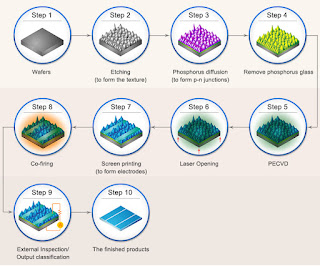Solar panels
Solar Panels - PV or Photovoltaic Panels
Photovoltaic cells or panels are only one way of generating electricity from solar energy. They are not the most efficient, but they are the most convient to use on a small to medium scale.
PV cells are mostly made from silicon (though a number of non silicon based methods are being developed), similar to that used in computer "chips". While silicon itself is a very abaundant mineral, the manufacture of solar cells (as with computer chips) has to be in a very clean environment. This causes production costs to be high.
A PV cell is constructed from two types of silicon, which when hit by solar energy, produce a voltage difference accross them, and, if connected to an electrical circuit, a current will flow.
PV cells are mostly made from silicon (though a number of non silicon based methods are being developed), similar to that used in computer "chips". While silicon itself is a very abaundant mineral, the manufacture of solar cells (as with computer chips) has to be in a very clean environment. This causes production costs to be high.
A PV cell is constructed from two types of silicon, which when hit by solar energy, produce a voltage difference accross them, and, if connected to an electrical circuit, a current will flow.

A number of photovoltaic cells will be connected together in an "Module", and usually encapsulated in glass held a frame which can then be mounted as required. The cells in a module will be wired in series or parallel to produce a spacified voltage. What may be refered to as a 12 volt panel may produce around 16 volts in full sun to charge a 12 volt battery.
In most cases, a number of panels (modules) will be connected together to form an "Array". Panels of a similar type may be connected in series to give a higher voltage (two 12 volt panels may be connected in series to produce 24 volts).
Usually a number of panels will be connected in parallel to give an increased current.
In most cases, a number of panels (modules) will be connected together to form an "Array". Panels of a similar type may be connected in series to give a higher voltage (two 12 volt panels may be connected in series to produce 24 volts).
Usually a number of panels will be connected in parallel to give an increased current.

Comments
Post a Comment